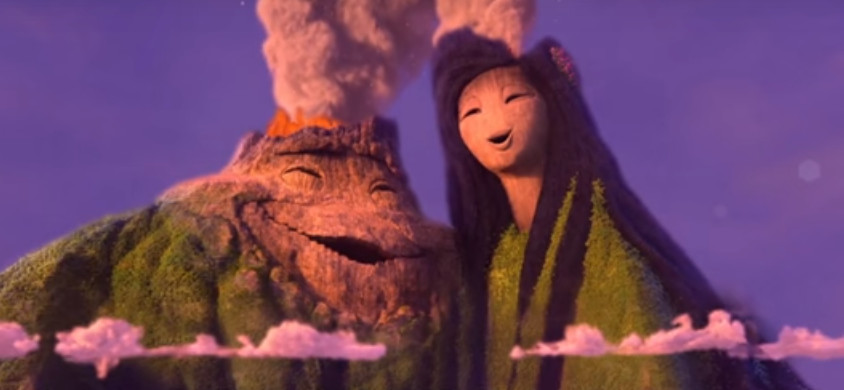Pixar is renowned for its ability to evoke powerful emotions through animation, and the short film Lava is a testament to this skill. Directed by James Ford Murphy, this musical short tells a unique love story set in the heart of the Pacific Ocean, focusing on a lonely volcano named Uku and his heartfelt Lava Song. This isn’t your typical action-packed Pixar short; instead, Lava unfolds as a series of beautifully rendered snapshots, narrated by a song that carries the emotional weight of the story. While visually simple, the impact of the lava song and the themes explored resonate deeply, offering a different kind of Pixar experience.
 Volcanic island Uku singing his lava song, longing for love in Pixar's Lava
Volcanic island Uku singing his lava song, longing for love in Pixar's Lava
What truly makes Lava stand out is its mesmerizing lava song. Sung with the gentle strumming of a ukulele, the song’s lyrics paint vivid pictures of longing and hope. It’s through this lava song that we understand Uku’s deep desire for companionship as he witnesses the world around him pairing up. The simplicity of the musical arrangement enhances the emotional core of the narrative, proving that Pixar’s storytelling prowess extends beyond complex animation and into the realm of heartfelt music. The lava song is not just background music; it is the storytelling, making it an unforgettable element of the short.
However, Lava‘s unique approach is also where it encounters some criticism. Unlike many Pixar shorts that rely on visual action and character movement to drive the narrative, Lava is almost entirely dependent on the lava song and static, postcard-like visuals. The story is told to the audience through the lyrics, rather than shown through dynamic animation. While this experimental approach is commendable and undeniably beautiful, it can feel slightly passive. One could even experience the story by simply listening to the lava song without watching the visuals, which deviates from the typical visually rich Pixar experience. This reliance on the lava song might leave some viewers, accustomed to Pixar’s usual visual storytelling, feeling slightly detached or even frustrated.
Another point of discussion is Lava‘s pairing with the feature film Inside Out. Thematically and stylistically, these two films are vastly different. Inside Out is a vibrant and fast-paced exploration of childhood emotions aimed at a younger audience, while Lava delves into mature themes of loneliness and longing with a more photo-realistic animation style. The emotional depth of the lava song and the overall tone of Lava might be overwhelming or simply mismatched for children expecting a film in the vein of Inside Out. This thematic disconnect led to some audience confusion and even distress, highlighting the challenge of pairing such disparate shorts with feature films.
Despite these points of contention, the beauty and emotional resonance of the lava song in Pixar’s Lava are undeniable. It represents a bold step in a different direction for Pixar’s short films, showcasing their willingness to experiment with narrative forms and rely on music as a central storytelling device. While the lack of action and mature themes might not appeal to all viewers, particularly when paired with a more lighthearted feature film, the heartfelt lava song and the poignant story of Uku and Lele offer a unique and moving cinematic experience. Ultimately, Lava might be a slightly unconventional Pixar short, but its emotional core, driven by the powerful lava song, leaves a lasting impression.


